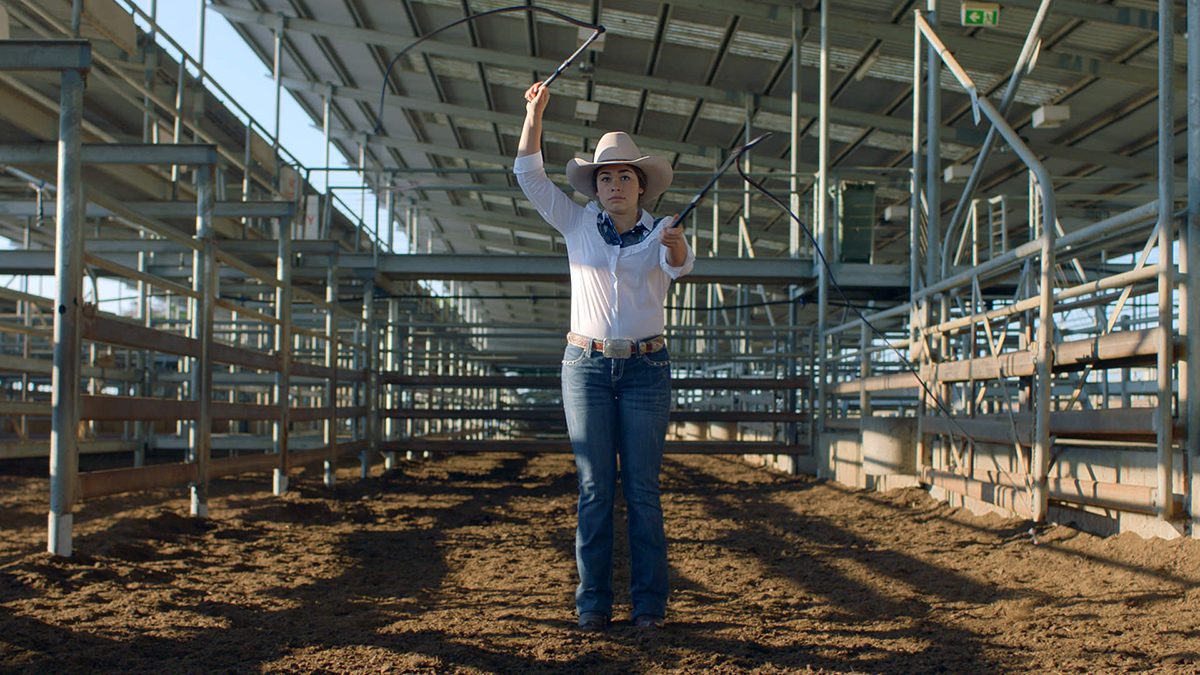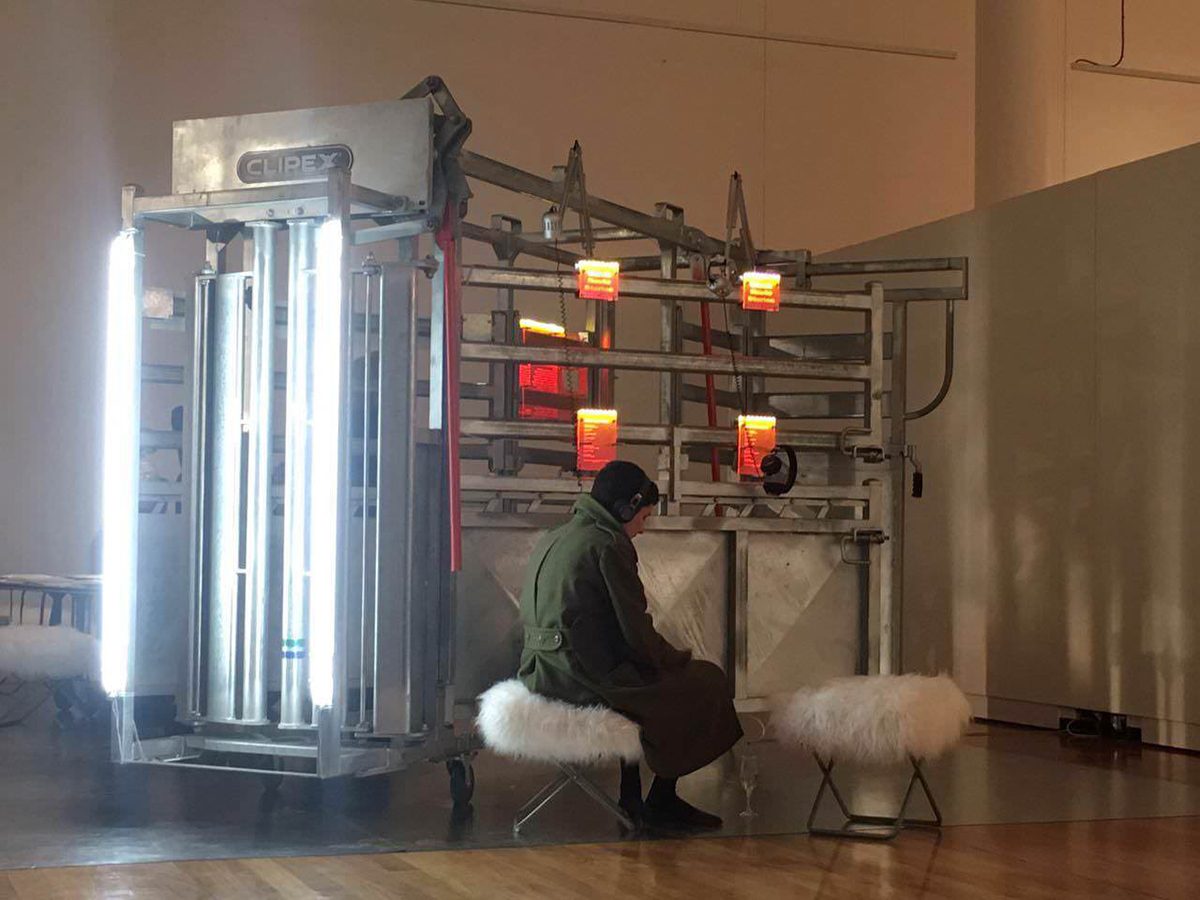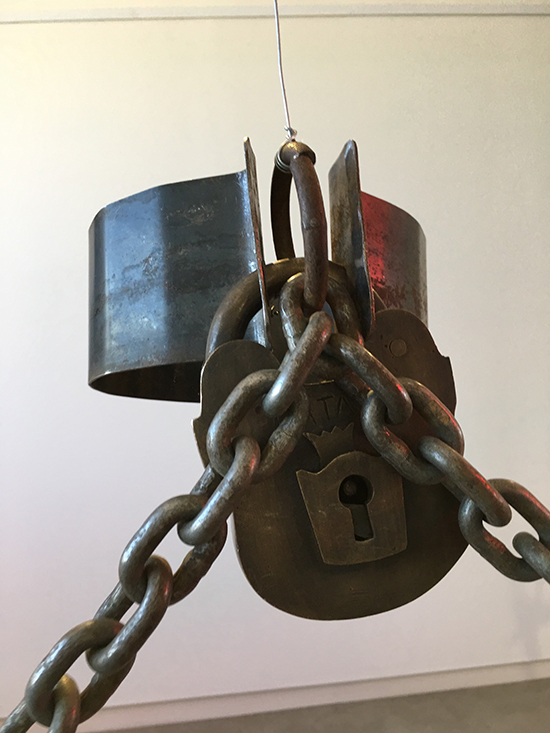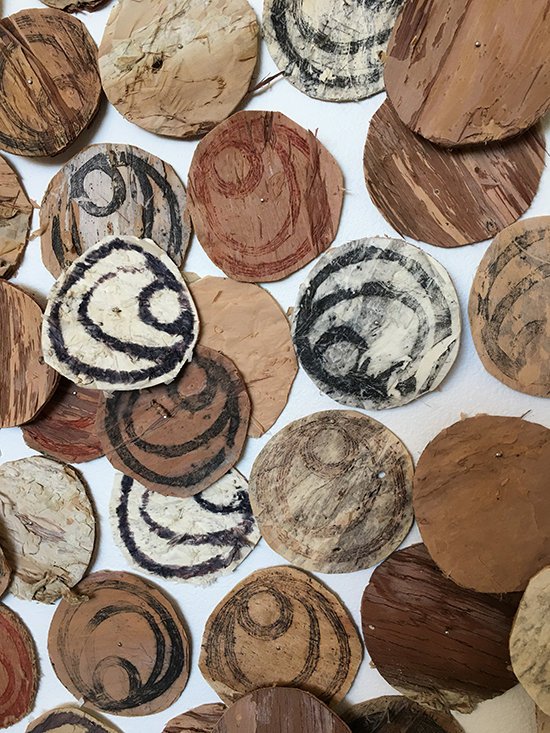On a chilly spring night in September, two tall churches blaze out from the dark in the town centre of Launceston, Tasmania. The first, St John’s Anglican, houses two participatory artworks. In one, Launceston Queen Bee performance artist Edwina Blush drops beads of honey into audience members’ palms. In the other, for local artist Kirsty Máté’s Knit, audiences sit in a circle knitting plastic bags into sleeping mats for the homeless. The second, the deconsecrated Presbyterian Chalmer’s Church, across the block, is lit with blue and purple and cast with the shadows of the young performers of Launceston’s Stompin interacting with the church facade twice nightly in Brisbane choreographer Liesel Zink’s site-specific SYCP2017.
The sight of these churches, otherwise conventional, Gothic spaces, repurposed for ephemeral, whimsical, site-specific contemporary art projects and thrown with vivid coloured light, perfectly captures the essence of Junction Arts Festival. Not merely staged in Launceston, it comes directly from the small but engaged community of its valley town. Junction is a grassroots festival that feels genuinely alive and without the PR gloss of many of its mainland counterparts.
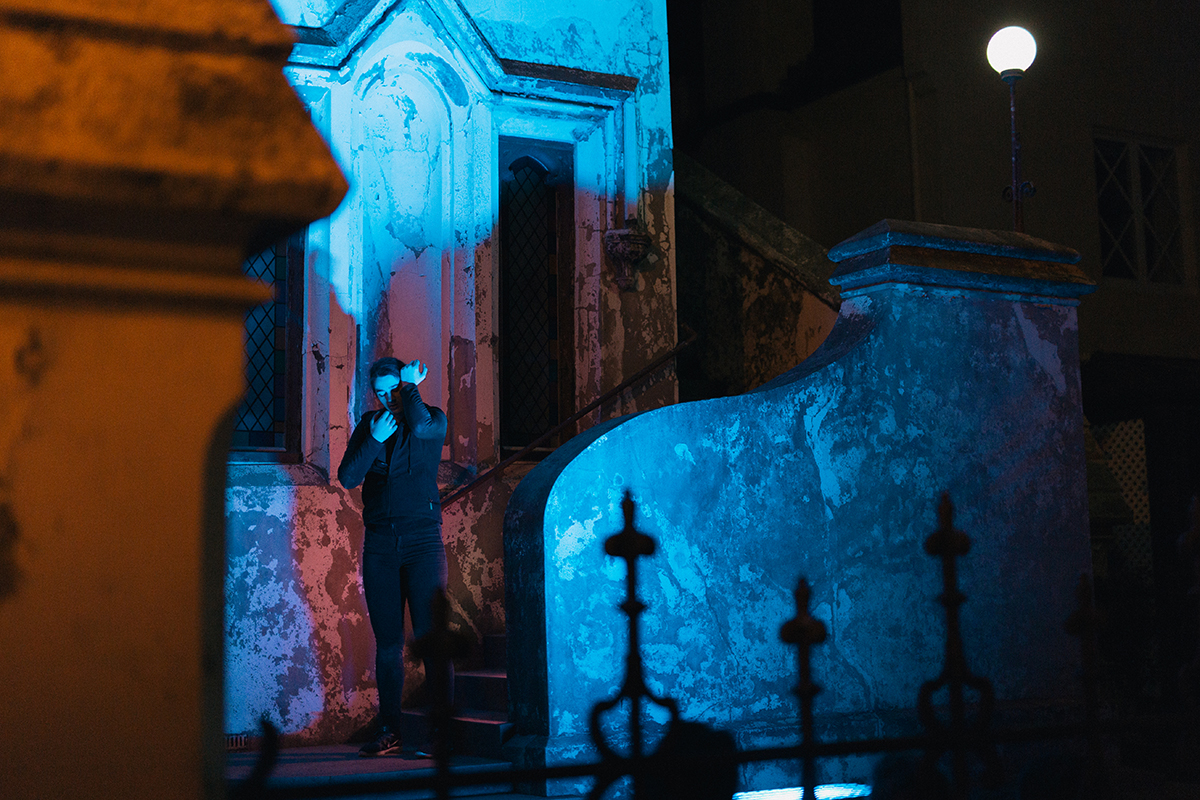
Stompin Youth Choreographic Project 2017 developed with Liesel Zink performed at Chalmer’s Church, Junction Festival, photo Jacob Collings
The festival takes place at a moment when the state of Tasmania is at its own junction. As Australia’s poorest state, one third of the island’s residents rely on some form of welfare and the workforce is split largely between tourism and hospitality, logging, mining, and government (over 50% of the state budget comprises public service wages). While uber-rich arts patron David Walsh’s Museum of Old and New Art has tilted Tasmania’s reputation (and economy) into a more positive space, continued mining and logging threaten to extinguish the very environmental beauty that the state’s growing tourism sector is founded upon, not to mention its ecological equilibrium. In a place where colonial history feels close to the present and the contradictions of late industrial capitalism seem more visible than elsewhere in Australia, the thoughts and actions of artists — and the broader arts community — have surfaced as genuine stabilisers of the economy.
Where the impact of arts festivals in the major cities can be diluted by sprawling urban populations and competing events, regionally focused ones have the potential to really electrify their communities. Walsh’s Dark MOFO pitches itself as a Gothic festival at the end of the world, while Ten Days on the Island festival also draws international and local artists into its program. Junction has no such pretensions — it locates Launceston’s local community at the centre rather than the edge of the world. The difference is about more than marketing speak. Junction has strategically switched from spending money on mainland and international acts to largely filling its program with local, Tasmanian artists. Though this year’s program is smaller than before, it’s oriented directly to Launceston citizens, whose demographic seems to be distinctively family-oriented. By basing itself in the centre of Launceston, with a large program of free events (nightly music, live comedy, self-guided art tours, light shows, a big public bar), Junction has been able to draw to it a reservoir of goodwill from local artists and community members.
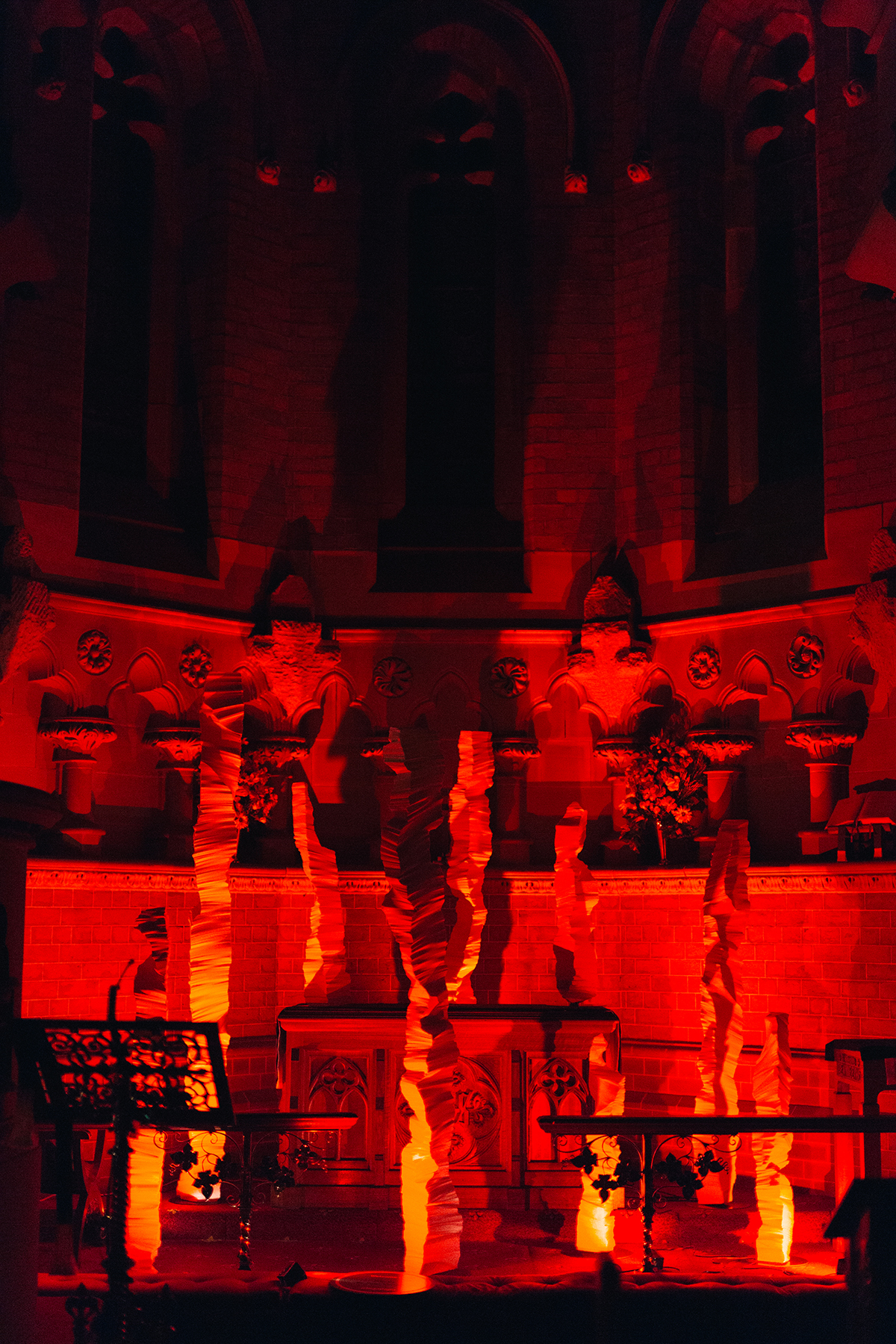
Paul Murphy, Traces, Junction Festival, photo Jacob Collins
Paul Murphy, Traces
The Nightlight program — a self-guided tour of site-specific art happenings in shops and other spaces surrounding Prince’s Square — provided the most interesting glimpses into Tasmania’s visual and community arts, including a wonderfully loopy community-photographic art project by Team Textiles called Masked Family Portraits, which lined the square’s north-eastern fence in a strange, friendly greeting to passers-by. In St John’s Church, the treatment of young Tasmanian designer and architect Paul Murphy’s Traces, hewn from styrofoam resembling delicate rose quartz and rendered in homage to seastack (geology) formations in Lake Pedder, was an illuminating example of how site-specific context can bring an artwork fresh energy and meaning. Cast with red light, the crystalline pillars formed their own, new conversation with the church’s vertical columns, and it became impossible to think of them installed conventionally in a pristine white cube gallery.
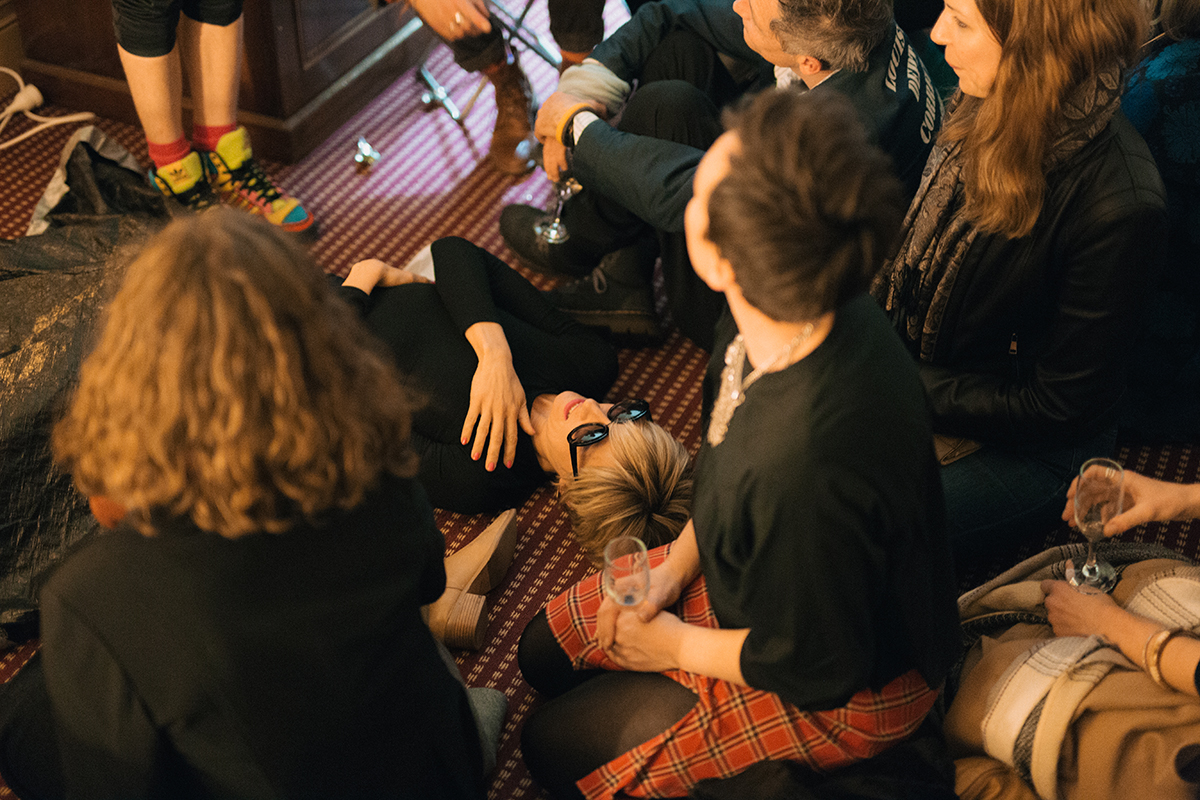
Uta Uber Kool Ja, Junction Festival, photo Jacob Collings
Uta Uber Kool Ja
Uta Uber Kool Ja provided the most lasting impression of the festival — of solidarity and community through live art. The concept, by actor Georgina Symes and performer and activist Nic Holas, is to use a hotel room as the stage for a new kind of intimate and immersive participatory performance, hurling the audience into an after party in the private suite of a rock star at Launceston’s Hotel Grand Chancellor. Desperately glamorous Uta Uber (Symes) is the centre of attention, and our host is her manager and confidant George (Holas) whom we meet in the hotel lobby before shuttling upstairs to the suite. We’re given glasses of bubbly and a warm welcome, but rather than the glitzy affair that’s promised, Uta has passed out behind the bedroom door on the other side of the suite. Once she rouses herself, it becomes clear she’s not the star she imagines herself to be. As she nostalgically recalls lost relationships with those more famous and important than her (Michael Hutchence), shines the dull glitz of her once-almost-sparkling career (her biggest hit made the top 20 behind the Iron Curtain) and launches a new remix with the lights out (dancing to the DIY strobe of a torch held by an audience member), we realise that Uta is a lot like a former child star — someone who’s been told she’s very special, only to be left dejected and prone to inflated overcompensations.
But the show has the utmost respect for Uta’s has-been status: a theme of overcoming failure — by building resilience and stitching together your family — comes into focus as the audience is brought into the bedroom, the suite’s inner sanctum. Uta’s journey is honourable for the very fact that she attempted it.
Given feather boas and trashy sunglasses to don, our transition into full-blown characters within the fantasy is complete. As we all pile onto the bed, Uta and George reveal themselves as Georgie and Nic, a breaking down of character that allows for a wonderfully self-reflexive epilogue in which Nic espouses the show’s values in a kind of late-night party polemic. “We’ve been telling people to ‘say yes’ at parties in every state in Australia for the last six years,” he says, addressing the ‘respectful’ debate around a certain postal vote at present. “And right now, at this moment in history, it may seem like all anyone is talking about is saying ‘yes’ or saying ‘no.’ I don’t assume what your politics are when you come to our party. If you’re a ‘no’ person, you are welcome here with Uta and I. If you are a ‘no’ person, I would like to let you know that standing in front of you is a person who would like you to say ‘yes.’ You’ve just met one, you can’t say you haven’t ever again. There are far more people who look and sound nothing like me, who don’t have the same freedoms and privileges I do, and they want you to say yes, too.”
Just as Uta Uber Kool Ja’s staging has changed as it has inhabited different hotel rooms across Darwin, Melbourne and Adelaide, its creators are nimble and responsive enough to allow each new moment to shift the show’s content. This particular installment of Uber became a declaration of love and togetherness — of uniting and saying (and voting) yes, even when failure is possible or the outcome you crave is not assured. A hit at mainland fringe festivals, Uta Uber Kool Ja showed me that contemporary performance can be presented to broad audiences in unusual spaces without sacrificing rigour or depth for funny, feelgood vibes. Launceston’s audiences were as respectfully disinhibited and keen to participate as any performance artist could wish for.
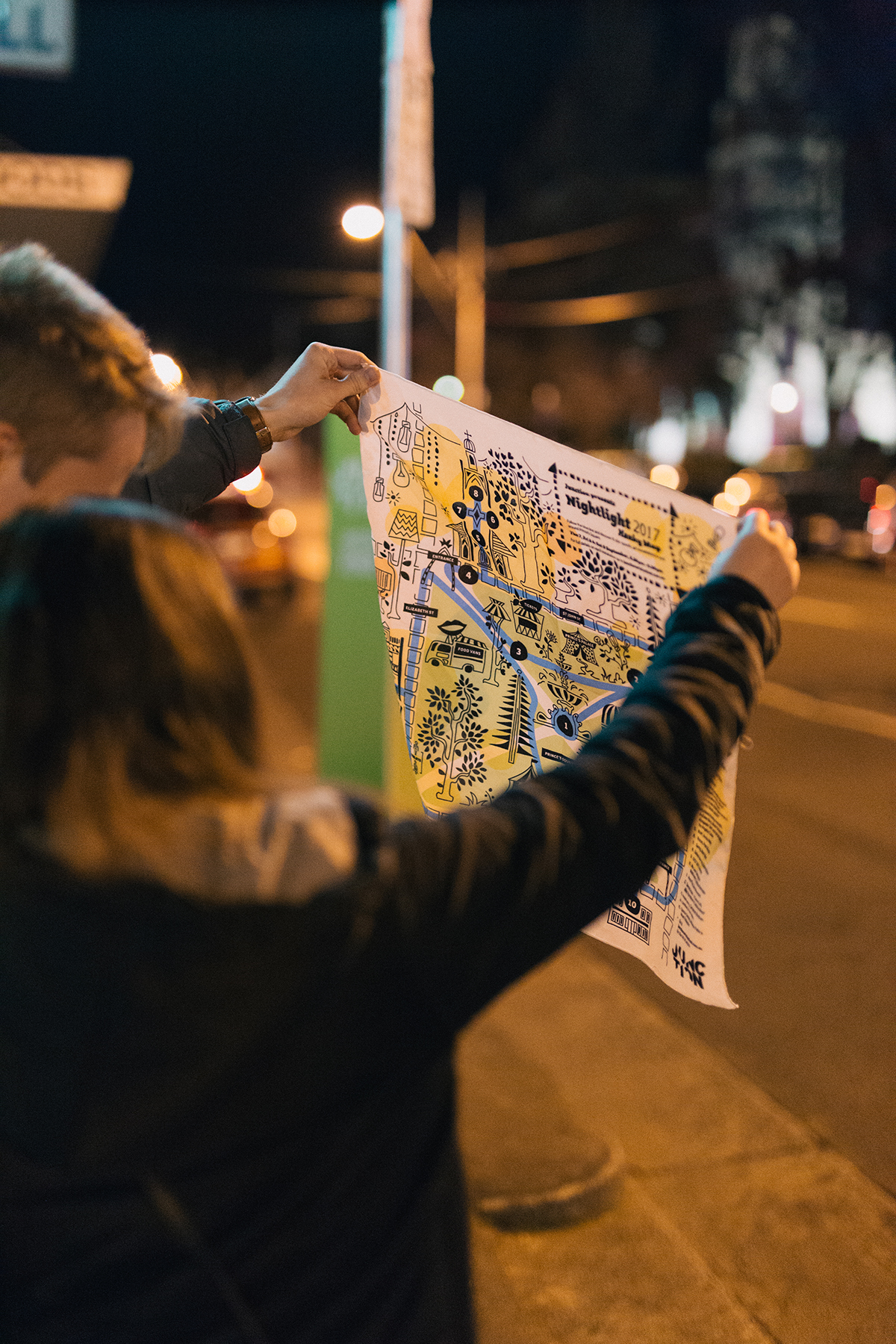
Hanky Map, Nightlight, Junction Festival, photo Jacob Collings
Local emergence
In his capacity as Creative Director, former Adelaide Fringe director Greg Clarke’s focus is on an outward-looking approach to programming that brings in the general public — indeed, most of the ticketed events sold out. It goes to show that there’s space in the arts ecology for all kinds of curatorial approaches. The mandate here is not a rigorously conceptualised and academic orientation to the insider art world, but a whimsical focus on fun, public-facing art projects that also relate directly to those making work in Launceston. That means for example, that Pronoun, an amateur theatre production of a fairly conventionally conceived stage-play about a trans teenager emerged from the work of students at Launceston College and was as rough-and-ready as you’d expect. But that’s where its charm lay — a more professional production would have likely used polished actors in their 20s rather than the actual teenagers who gave Pronoun its authenticity and rawness. In that sense, Junction has a more inclusive view of the arts ecology — including its local schools, colleges and high school teachers, and a brand new theatre company, Pronoun’s producer Relevant — than many big-city cultural events.
Earlier this year, Junction Arts Festival secured $1.25 million in state government funding until 2021. It’s good to know that Prince’s Square will light up again in September for the next four years. Illuminated in fluoro each night and designed by local emerging lighting designer and Launceston College student Ethan Stanley, Prince’s Square didn’t have anything as high-tech as Vivid Sydney, but it’s nice to think of its rainbow-lit trees as emblems of what small Australian cities could more frequently accommodate in terms of welcoming, lively art events, with the will and inclination of councils and policy makers and those within the arts keen to look beyond the east coast metropolis.
–
Junction Arts Festival, creative director Greg Clarke; Prince’s Square and surrounds, Launceston, 6-10 Sept
Lauren Carroll Harris was a guest of the festival.
Top image credit: Nightlight with Masked Family Portraits, Junction Festival, photo Jacob Collings
Large, geodesic, candy-pink: at first appearance Future Method Studio’s Buckminster Fuller-inspired dome tent, filled with white pebbles and bits of flint, is a surprising presence in a gallery show about Australia’s long paddock. That phrase—long paddock—is a colloquialism, a settler-colonial buzzword for the travelling stock routes (TSRs) that once traversed and now patchwork the continent. Joni Taylor from the New Landscapes Institute has curated a show situated at the intersection of architecture and art that explores the layered histories of the TSRs at a time when access to public land is more contentious than ever. The exhibition is the first iteration of a long-term project engaging with the uncertain future of this important public resource.
Classified as crown land, today TSRs are liminal zones used for myriad purposes. Farmers, birdwatchers, beekeepers, bushwalkers, ecologists and traditional owners all have a stake in their future. Up on the gallery wall, near the dome, Future Method Studio has created a map that charts the locations across NSW where the TSRs intersect with places of Aboriginal significance. It’s an impressively detailed and important document and to my knowledge no other map like it exists.
As the artists in this show acutely understand, the problem with maps is that they formalise a kind of forgetting. By prioritising one set of concerns, others fade away. Living and working in the Riverina, The Wired Lab (see a 2014 RealTime TV interview with director Sarah Last), are particularly sensitive to this, using two different maps, one historical, one spatial, to contextualise a mesmerising soundscape featuring local activist Peter Beath speaking in Wiradjuri—a language declared extinct in 2007 but which in fact survives—and field recordings from TSRs local to the area, a lively racket of cicadas, birds and insects. It’s The Wired Lab work, Lines of movement, a Wiradjuri history, that feels the most essential; human and non-human occupants are given equal ground from which to speak.
Looking at the TSRs from an economic perspective led artist Zanny Begg to the bullwhip effect, an economic term that describes accelerating unpredictability within complex supply chains. The bullwhip is also a uniquely Australian whip and the first human invention with the capacity to break the sound barrier. Begg’s film, The Bullwhip Effect, features a virtuosic demonstration by 17-year-old Emiliqua East, one of the world’s best whipcrackers. Slowed down to 200 frames per second, she becomes a medusa-like figure, totally focused, barely blinking, two whips writhing and cracking around her with stunning precision. Shot and soundtracked in a manner that playfully engages Western genre tropes, East enters and exits the film walking slowly through a labyrinthine, stainless steel cattleyard.
In Untitled Incognito, Megan Cope and Bill Buckley present a reworked version of an Aboriginal windbreak made from a mix of traditional and non-traditional materials. Its ochre-painted surface is used as a screen, onto which two images are overlaid: rippling water from the Murrumbidgee and a map of local TSR coordinates. The work asks important questions about who the TSRs are for, and what they might become. As of April the NSW TSRs have been placed under formal review. What if this land were to be repatriated to traditional owners?
Architecture collective Grandeza offers a global perspective in The Plant, presenting a case study on similar stock routes throughout Spain. Alongside this, they have created a portable conversation arena and an adapted version of the cattle crush (a holding stall), programmed with recordings from members of the community telling their stories about the TSRs. The architectural contributions of both Grandeza and Future Method Studio bring a sense of public agency into the gallery and activate the exhibition as a site of political action.
Back to the dome, which on closer inspection represents the concept of “a keeping place” — a place where Aboriginal cultural materials are held safely. Setting aside places as symbolic space where Aboriginal systems can be honoured is a concept that has been written into bureaucratic systems; for example, there are keeping places held on-site at mining locations where artefacts have been incidentally dug up. Cultural items are stored temporarily and then repatriated once the land is no longer being used.
In Future Method Studio’s Future Acts, the keeping place marks an important moment in their research. While they were at a stock route location, artists from the Studio and their Aboriginal collaborators came across a significant number of Aboriginal artefacts sitting in the topsoil. The experience resonated in two ways: it showed just how twinned the relatively recent history of the stock routes is with the long history of Aboriginal land custodianship. And it showed just how bad whitefellas have been at seeing what’s in front of them. The pink dome, a shape that recalls the activist politics of the US counterculture movement, operates recursively, as aura and totem. Presenting and representing the concept of keeping place, a warm ethics of care washes over the gallery as a whole.
—
The Long Paddock, curator Joni Taylor of New Landscapes Institute, artists Zanny Begg, Megan Cope & Bill Buckley, Hayden Fowler, Future Method Studio, Grandeza, Josephine Starrs & Leon Cmielewski and The Wired Lab; Wagga Wagga Art Gallery; 6 May-17 July
Emily Stewart is poetry editor at Giramondo Publishing and a doctoral student in the Writing and Society Research Centre at WSU. She is the author of Knocks (Vagabond Press 2016).
Top image credit: Future Method Studio, Rylestone Travelling Stock Route, fieldwork for The Long Paddock, 2017, photo Rosie Krauss
Artlands is the new “brand” name for the bi-annual national Regional Arts Australia Conference and Festival which this year hosted international speakers alongside delegates from across the nation. Held in Dubbo, its ambitious and densely packed program was animated by the themes regeneration, connectedness and emergence. While it was possible to experience these in various combinations, this report reflects my own interests in the program, focusing on several highlights of its investigation into what we might mean by ‘regional’ in contemporary global culture.
A UK perspective: diversity and community
Skinder Hundal, Chief Executive, New Art Exchange, Nottingham UK spoke about New Art Exchange as a hub of cultural and social reinvention through diversity and experimentation in creative practice, focused on local/global interaction, and the engagement of local audiences by using local histories and practices. As well, he questioned our assumptions about how the arts ecology works, delivering a timely case study on the arts as a driver of inner city regeneration and bringing communities together. Rather than rethinking the idea of region, he proposed that we rethink the idea of centre. This was an exciting proposal, although the differences between UK and Australian regions are very marked.
Art practice and health
Focusing on ways to engage artists as agents of change in immediate and direct ways, exemplary presentations on this complex topic ranged from a discussion of art and social justice to art as a measure of quality of life, especially made meaningful through creative expression, including in the face of death and in tackling a serious crisis, such as HIV in the Free State of South Africa. When health funding is very limited, artists can be instrumental in creating strategies and discourse.
Here in Australia, Kym Rae, Director of the Gomeroi gaaynggal (Babies from Gomeroi lands) program, was very frank about the way fostering creative practice in First Nations communities could have a significant impact on mental health outcomes in much quicker timeframes than a solely medical approach.
Rural routes
On recasting art and theatre practice in rural communities, Henk Keizer, Co-Coordinator of Rural Routes in The Netherlands, spoke about long-term projects in the farming areas of the Netherlands that have needed, and employed, artists to articulate community experiences and concerns to government, commissioning theatre and performance to communicate more effectively. With regard to methodology, including in terms of research and development and the need to invest time in rural locations and communities, this was an effective lesson in the demise of fly-in-fly-out approaches to cultural production.
By contrast, even with a distinguished line-up of speakers—Michael Brand, Director, Art Gallery of NSW, Dolla Merrilees, Director, Museum of Applied Arts and Sciences, Blair French, Director Curatorial and Digital, Museum of Contemporary Art, Caroline Butler-Bowden, Director of Curatorial and Public Engagement, Sydney Living Museums and Steven Alderton, Director Programs, Exhibitions and Cultural Programs, Australian Museum—the institutional presence of large key organisations provided little more than animated press releases (albeit quoting some impressive regional audience numbers for their programs), but a dearth of considered embedding of cultural process over time. The MCA’s C3West, a long-term project in Western Sydney (in partnership with councils and businesses) was an example of artists working with communities to deal with urban social and cultural issues, but without necessarily serving as a transferable model for regional needs.
The exceptions here were Sydney Living Museums, clearly taking the initiative with ongoing programming, and the Australian Museum with its considered repatriation of Indigenous objects program and community building through working with families and in relation to artefacts in its collection. These programs seem symbolic of real institutional change, deep understanding of cultural issues and the inclusion of Aboriginal history.
First Nations
The heart of the conference was without question the generous and rigorous presentations by First Nations speakers. I cannot stress enough the power of their direct address—based in personal experience—to move, inspire and galvanise.
In his opening keynote about sovereignty Mark McMillan, Associate Professor, Melbourne Law School invited us to consider creative making as a meeting place, where acknowledging sovereignty is a personal, transformative and mutual experience that takes place through culture and cultural production.
Lee-Ann Buckskin spoke eloquently about mentoring and agency, championing the expertise and experience of First Nations artists and arts workers; and Rhoda Roberts articulated the impact of institutional intent in including First Nations content and context across all aspects of cultural production. I particularly valued her impatience with ‘closing the gap’ rhetoric and her provocation that instead of First Nations people adopting Western cultural aspirations, that the broader population should “sit down with us.” I can only hope that these ideas are taken up by all who attended, and that this translates into action across the sector.
Wala-Gaay
A highlight of the Festival program was a small but coherent exhibition at the Fire Station Arts Centre. Wala-Gaay was an ambitious group show of artists who were part of the Orana Arts Left Field Project, a long-term creative mentoring program in its second year. It presented a collection of powerful, visceral, diverse works engaged with historical references, lived experience and culture in the present. All were by local regional artists who were encouraged throughout the project to work in new ways with previously untried materials.
Jason Russell’s (Worimi) Taken from Country is both a visceral image of violence and colonial rule, and a highly resolved physical presence that brings the viewer into the work. Arresting from the moment you enter the space, neck irons hang in line in front of an old saddle, keys attached—symbols of imprisonment and subjugation, equal parts beauty and horror.
Locked up, by Dylan Goolagong (Wiradjuri), reflected on museum practice and its historical roots in theft and acquisition, asking who has access to and who act as gatekeepers for First Nations cultural artefacts. A series of crosses and carved wooden blocks hidden in a set of old steel lockers, the work questioned viewers’ notions of what is sacred by placing a physical barrier—a closed door—between us and some elements of the piece, while echoing the systems and structures of collection and display.
Our girls by Paris Norton (Gamilaroi) is a lyrical and painstaking memorial to young women who were stolen and taken to homes to be trained for a life of domestic servitude by the Aboriginal Protection Board. Each hand-painted and hand-cut circle of paperbark, as personal as a fingerprint, is an eloquent stand-in for records that were lost or destroyed, and lives profoundly altered, under this regime.
All these works are direct yet densely layered and moving. There is not space here to discuss the equally accomplished works by Aleshia Lonsdale, Alex Nixon and Robert Salt; and credit must also go to mentors Blak Douglas, Jonathon Jones, Chico Monks, Nicole Monks and Jason Wing, and curators Khaled Sabsabi and Emily McDaniel. While there were moments where the viewer could see the influence of a mentor, there was more a sense of artists entering into a field of practice rather than imitation, and the diversity of the work was testament to the benefits of structured support and creative dialogue. It was exciting to see a local event that so clearly stood out in an abundant program of interesting work from around the nation. This is a show that deserves to tour; and I hope to see more work – more bodies of work – by these artists in the future.
Conference/Festival divide
One of the troubling issues of the event however, was something of a separation between the conference and the festival. This was particularly visible for me as I spoke to local artists who felt ‘priced out’ of a conference where the frameworks and practices that shape the arts system with which they engage were up for debate. While being part of the festival was of course a valuable opportunity, and included artists from other regions as well, there still seemed an unnecessary and problematic divide between the makers and the decision-makers. Few artists were involved in articulating how to proceed in the cash-strapped present. (And if organisers think that the cost to attend was not prohibitive for many artists, then they need to get to know the reality of artists’ incomes a little better.)
Equally, given the ways artists were being recognised as the motor of engagement, community building and delivering outcomes, a dialogue with what artists need to produce these outcomes—over the long term, and with adequate remuneration—should have been an important inclusion. Austerity politics and diverted funding have devastated budgets within the arts, but also in arenas where artists are increasingly the service bearers of not just creative or cultural outcomes, but diversity, health and community outcomes as well. And in this context is it too much to expect inclusivity to extend to queer artists and artists with disability? Both were conspicuous in their absence from the programs I attended.
Rethinking ‘regional’
The conference concluded with a discussion of the future and a panel on thought leadership, bringing together Wesley Enoch, Artistic Director, Sydney Festival, Lindy Hume, Artistic Director, Opera Queensland and Mathew Trinca, Director, National Museum of Australia to imagine futures, collaborations and new approaches. While attempting to redefine the idea of what the regions are—in their diversity—there was a clear call for us as a field to name and promote and value what we already do, and to articulate that value more effectively in order to have it recognised.
I think Wesley Enoch queried the term ‘regional’ in the most productive ways: through speculating about working region to region, relocating large companies to regional towns and suggesting that large established institutions and organisations forego government funding. I took this to mean in favour of the smaller organisations that form such a significant testing ground in the arts ecology. He also proposed no longer taking culture to the regions, instead developing and supporting culture in the regions, and in a global not just national context. He also suggested how we can all take action in the current climate: go to more shows, practice your elevator pitch and meet five strangers and start a dialogue that lasts at least a year.
–
The next ARTLANDS will be hosted by Regional Arts Victoria in 2018.
ARTLANDS Conference and Festival, Dubbo, NSW 27-30 Oct
Liz Bradshaw is an artist and cultural researcher. She gave a presentation at ARTLANDS on creative education for dLux Media Arts.
Top image credit: Locked Up, Dylan Goolagong, Wala-Gaay, photo Liz Bradshaw
Interview with Cad Factory Artistic Director, Vic McEwan about A Night of Wonder, an evening of installation and performances onsite at the the Coleambally SunRice Mill in regional NSW.
Vic McEwan, Mayu Kanamori and visiting Japanese artist Shigeaki Iwai were in residence at the mill for three weeks developing responses to the site in consultation with mill workers and the local Coleambally community.
A Night of Wonder, 21 Sept, 2013
Video footage: Sam James
Editing: Gail Priest


